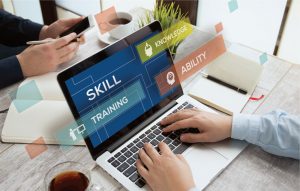Preparing for the Future of Learning
Feature Story – By Josh Gleim
Learners are looking for new ways to process training content as efficiently as possible.
 The way people consume information today has changed dramatically, and it’s not just the millennials. Generation X and baby boomers have also changed the way they choose to get information. We live in a 4-plus screen world, relying on smartphones, tablets, computers, televisions and more. Major marketing firms have made significant investments in trying to understand how these different groups are consuming content. What they have learned is that consumers in these generational groups are discovering new ways to process content as efficiently as possible. Thus, content format must be converted for ease of consumer consumption.
The way people consume information today has changed dramatically, and it’s not just the millennials. Generation X and baby boomers have also changed the way they choose to get information. We live in a 4-plus screen world, relying on smartphones, tablets, computers, televisions and more. Major marketing firms have made significant investments in trying to understand how these different groups are consuming content. What they have learned is that consumers in these generational groups are discovering new ways to process content as efficiently as possible. Thus, content format must be converted for ease of consumer consumption.
These same principles of marketing can also be applied to learning. Today’s corporations are not “aging,” they are becoming “multi-generational.” And learners in these corporations are also looking for new ways to process training content as efficiently as possible. So how do you adapt to these changing needs?
Corporations are transitioning from a top-down approach to a continuous learning strategy. Training content should be available to learners when and where they need it. While traditional classroom and eLearning can remain components of a larger learning journey plan, they alone do not provide a continuous learning experience. These platforms limit when and how learning can occur.
There are several buzzwords in the training industry being used to describe recent learning tactics and methodologies, such as microlearning, adaptive, gamification, social and immersive. Some of these words are not new but have taken on new meaning as technology has evolved. Common to these buzzwords is that they describe a type of learning experience. Each of these experiences on its own provides limited utility, but employed together, can provide a very powerful continuous learning journey. The learning experiences can be organized into three categories: adaptive, just-in-time, and social. While there are several ways to approach a learning journey, these categories provide the basic ingredients of a continuous learning journey.
Adaptive Learning
Adaptive learning is the keystone of the learning journey. To provide a journey that
will maximize the learner’s experience and outcome, you must first understand
their need. The learner’s knowledge should be evaluated considering a clear set of
competencies and objectives to identify individual gaps. Those gaps should then
be addressed through an individual learning journey, rather than a one-size-fits-all approach. The journey should continuously reinforce knowledge mastery through a spaced repetition of practice opportunities instead of traditional assessments. Spaced repetition is simple but highly effective because it maximizes the way the brain retains information over time. The next two learning categories, just-in-time and social, provide additional learning experiences that support the adaptive learning process and round out the continuous learning journey.
Just-in-Time Learning
Just-in-time learning provides learners with a variety of tools and processes that support the continuous learning journey while providing access to knowledge-based content in real time. Just-in-time learning is meant to be casual learning, not required. It should provide a learner with content that can help them excel on the job and should be easily accessible, mobile first, and optimized for accessibility. YouTube is an example of just-in-time learning. A person can search YouTube on a smartphone, tablet, or computer and instantly find a short video to master a specific skill, such as cooking techniques or home repairs. Implementing an on-demand content platform should be embraced as a model for keeping up with today’s fast-moving business environment.
Preparing for the future of training requires a paradigm shift from a top-down approach to a continuous learning journey.
 Social Learning
Social Learning
Social learning has become one of the latest hot topics in learning. It’s also vastly different from the other methods of training, and organizations struggle with how to properly implement it. Social learning is different because it occurs organically and does not fit into traditional top-down implementation. Those who are implementing social learning often try to force learners to use specific social tools to collaborate and share and want to ensure what they share is accurate. This seems like a reasonable approach and would be for traditional learning platforms.
The problem with this approach is that it assumes social learning should be imposed on learners. Social learning works best when individuals and teams have a genuine purpose, need, or interest in doing so, rather than because they are expected to do so. This is a significant paradigm shift from traditional learning practices.
In a highly regulated industry, social learning may seem impossible, but it should not be ignored. People learn by observing others’ behaviors, attitudes and outcomes of those behaviors, and will emulate behaviors that are perceived to be successful. For that reason, social learning is an essential component of the continuous learning journey that can organically challenge habits and facilitate behavioral changes.
Measurement Plan and xAPI
Finally, the learner journey should include a measurement plan that translates the learning journey into metrics that can measure if business objectives are being met, and the implementation of that plan should specify how the metrics will be captured from each touchpoint in the learning ecosystem. The traditional learning management system (LMS) does not tell us how learners engage with experiences that occur inside or outside of the LMS. Enter Experience API (application programming interface).
Experience API (or xAPI) is the newest specification for learning technology that makes it possible to collect data from every touchpoint in the learning journey. xAPI can capture data about a person’s or group’s activities from many technologies in a consistent format. Different systems can communicate by capturing and sharing simple xAPI statements.
Another key benefit of xAPI is that the data statements can be collected and securely stored into a single learning record store (LRS). Centralizing the data eliminates the painstaking process of mining through various platforms and dashboards to find and merge relevant data.
Conclusion
In summary, preparing for the future of training requires a paradigm shift from a top-down approach to a continuous learning journey. A learning journey should provide learners with opportunities to continuously practice and reinforce their knowledge, provide easy access to content when needed, and foster organic learning from top performers and peers. Finally, the journey should provide a measurement plan that ties learning to performance and shows how learners are working to improve their development.
Josh Gleim is senior director, interactive platforms & digital development, for
Axiom. Email Josh at Josh.Gleim@axiomhh.com.









